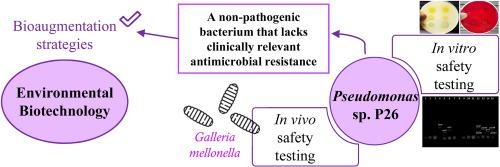当前位置:
X-MOL 学术
›
Environ. Pollut.
›
论文详情
Our official English website, www.x-mol.net, welcomes your feedback! (Note: you will need to create a separate account there.)
Safety attributes of Pseudomonas sp. P26, an environmental microorganism with potential application in contaminated environments
Environmental Pollution ( IF 8.9 ) Pub Date : 2024-03-18 , DOI: 10.1016/j.envpol.2024.123818 Constanza Belén Lobo , Rocío Daniela Inés Molina , Paula Moreno Mochi , Juan Martín Vargas , María Ángela Jure , María Silvina Juárez Tomás
Environmental Pollution ( IF 8.9 ) Pub Date : 2024-03-18 , DOI: 10.1016/j.envpol.2024.123818 Constanza Belén Lobo , Rocío Daniela Inés Molina , Paula Moreno Mochi , Juan Martín Vargas , María Ángela Jure , María Silvina Juárez Tomás

|
Currently, the selection of non-pathogenic microorganisms that lack clinically relevant antimicrobial resistance is crucial to bioaugmentation strategies. sp. P26 (P26) is an environmental bacterium of interest due to its ability to remove aromatic compounds from petroleum, but its safety characteristics are still unknown. The study aimed to: a) determine P26 sensitivity to antimicrobials, b) investigate the presence of quinolone and β-lactam resistance genes, c) determine the presence of virulence factors, and d) evaluate the effect of P26 on the viability of (an invertebrate animal model). P26 antimicrobial sensitivity was determined using the Kirby-Bauer agar diffusion method and the VITEK 2 automated system (BioMerieux®). Polymerase Chain Reaction was employed for the investigation of genes associated with quinolone resistance, extended-spectrum β-lactamases, and carbapenemases. Hemolysin and protease production was determined in human blood agar and skimmed-milk agar, respectively. In the assay, different doses of P26 were injected into larvae and their survival was monitored daily. Control larvae injected with KT2440 (a strain considered as safe) and PA14 (a pathogenic strain) were included. sp. P26 was susceptible to most evaluated antimicrobials, except for trimethoprim-sulfamethoxazole. No epidemiologically relevant genes associated with quinolone and β-lactam resistance were identified. Hemolysin and protease production was only evidenced in the virulent strain (PA14). Furthermore, the results obtained in the experiment demonstrated that inocula less than 10 CFU/mL of P26 and . KT2440 did not significantly affect larval survival, whereas larvae injected with the lowest dose of the pathogenic strain . PA14 experienced instant mortality. The results suggest that sp. P26 is a safe strain for its application in environmental bioremediation processes. Additional studies will be conducted to ensure the safety of this bacterium against other organisms.
中文翻译:

假单胞菌属的安全属性。 P26,一种在污染环境中具有潜在应用潜力的环境微生物
目前,选择缺乏临床相关抗菌药物耐药性的非病原微生物对于生物强化策略至关重要。 sp。 P26(P26)是一种令人感兴趣的环境细菌,因为它能够去除石油中的芳香族化合物,但其安全特性仍不清楚。该研究旨在:a) 确定 P26 对抗菌药物的敏感性,b) 研究喹诺酮和 β-内酰胺耐药基因的存在,c) 确定毒力因子的存在,以及 d) 评估 P26 对(无脊椎动物模型)。 P26 抗菌敏感性使用 Kirby-Bauer 琼脂扩散法和 VITEK 2 自动化系统 (BioMerieux®) 测定。聚合酶链反应用于研究与喹诺酮耐药性、广谱β-内酰胺酶和碳青霉烯酶相关的基因。分别在人血琼脂和脱脂乳琼脂中测定溶血素和蛋白酶的产生。在该测定中,将不同剂量的 P26 注射到幼虫中,并每天监测它们的存活率。注射了 KT2440(一种被认为是安全的菌株)和 PA14(一种致病菌株)的对照幼虫也包括在内。 sp。 P26 对大多数评估的抗菌药物敏感,但甲氧苄氨嘧啶-磺胺甲恶唑除外。没有发现与喹诺酮类和β-内酰胺耐药性相关的流行病学相关基因。仅在强毒株(PA14)中发现溶血素和蛋白酶产生。此外,实验中获得的结果表明,P26和.的接种量低于10 CFU/mL。 KT2440 并没有显着影响幼虫的存活,而幼虫注射了最低剂量的致病菌株。 PA14 立即死亡。结果表明 sp。 P26 是一种在环境生物修复过程中应用的安全菌株。将进行更多研究以确保这种细菌对其他生物体的安全性。
更新日期:2024-03-18
中文翻译:

假单胞菌属的安全属性。 P26,一种在污染环境中具有潜在应用潜力的环境微生物
目前,选择缺乏临床相关抗菌药物耐药性的非病原微生物对于生物强化策略至关重要。 sp。 P26(P26)是一种令人感兴趣的环境细菌,因为它能够去除石油中的芳香族化合物,但其安全特性仍不清楚。该研究旨在:a) 确定 P26 对抗菌药物的敏感性,b) 研究喹诺酮和 β-内酰胺耐药基因的存在,c) 确定毒力因子的存在,以及 d) 评估 P26 对(无脊椎动物模型)。 P26 抗菌敏感性使用 Kirby-Bauer 琼脂扩散法和 VITEK 2 自动化系统 (BioMerieux®) 测定。聚合酶链反应用于研究与喹诺酮耐药性、广谱β-内酰胺酶和碳青霉烯酶相关的基因。分别在人血琼脂和脱脂乳琼脂中测定溶血素和蛋白酶的产生。在该测定中,将不同剂量的 P26 注射到幼虫中,并每天监测它们的存活率。注射了 KT2440(一种被认为是安全的菌株)和 PA14(一种致病菌株)的对照幼虫也包括在内。 sp。 P26 对大多数评估的抗菌药物敏感,但甲氧苄氨嘧啶-磺胺甲恶唑除外。没有发现与喹诺酮类和β-内酰胺耐药性相关的流行病学相关基因。仅在强毒株(PA14)中发现溶血素和蛋白酶产生。此外,实验中获得的结果表明,P26和.的接种量低于10 CFU/mL。 KT2440 并没有显着影响幼虫的存活,而幼虫注射了最低剂量的致病菌株。 PA14 立即死亡。结果表明 sp。 P26 是一种在环境生物修复过程中应用的安全菌株。将进行更多研究以确保这种细菌对其他生物体的安全性。



























 京公网安备 11010802027423号
京公网安备 11010802027423号